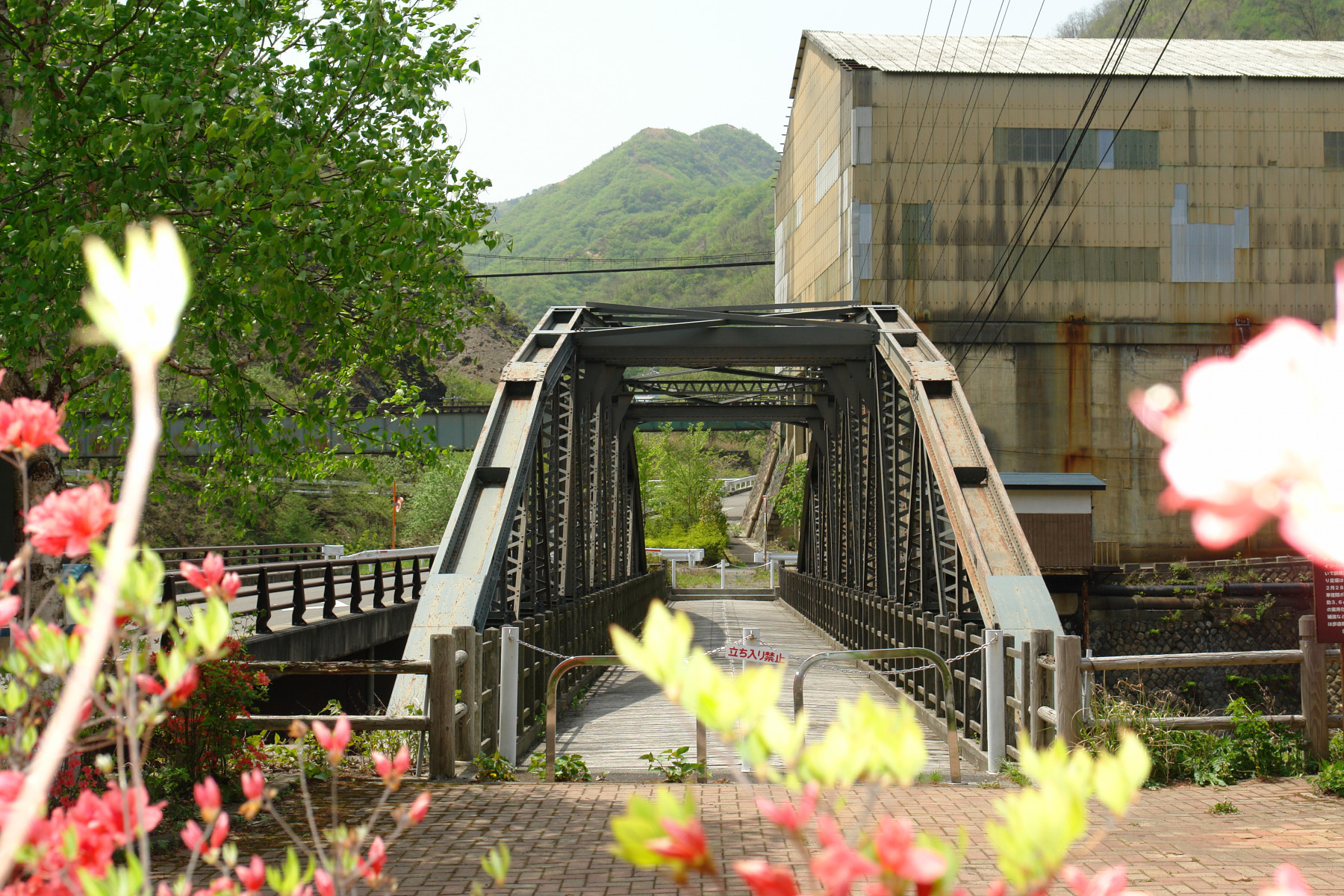産業遺産の見どころ
割烹旅館暢和館跡 TYOWAKAN OF COOKIG HOTEL FOR FURUKAWA CO.LTD1893~1940

栃木から鹿沼に移住した関塚嘉平氏は、足尾銅山へ引き売りに来ました。嘉平氏は茨城の海からも新鮮な魚を仕入れ活気づいた市場は面白いように売れましたが、足尾銅山の支払いはまとめて翌月なのでたまりません。そこで嘉平氏は足尾へ移住してしまいました。気骨があり人徳があるので古河の要人にえらく気に入られ、割烹旅館暢和館が与えられ、一族で古河のために働いてくれるよう頼まれます。
のちに長男暢一郎氏は掛水賄として、古河掛水俱楽部で修業させられたフランス料理を振舞うことに。また、喜平氏は東京へ出て築地精養軒へ弟子入りし、そこには天皇の料理番秋山徳蔵が兄弟子でおりました。のちに徳蔵に与えられた天皇からの勲章や杯を祈念に譲り受けることになります。現在、喜平氏の長男の長男信行氏が大井町で祖父の名喜平という洋食屋さんとして意志を継いでいます。
さらに、喜平氏の四男の康男氏は、日本のフランス料理界の重鎮で、平成23年に魯理人という日本におけるフランス料理人の歴史本を編纂いたしました。割烹旅館暢和館は昭和15年の大火で焼失してしましました。
THE RUINS OF CHOWAKAN; A HOTEL SERVES AUTHENTIC JAPANESE CUISINE 1893-1940
Kahei Sekizuka, who moved from Tochigi to Kanuma, came to Ashio Copper Mine for business. Kahei stocked in fresh seafood from Ibaraki and sold it at the market, which was a great commercial success. However, Kahei found the payment system very inconvenient: the total revenue paid on the next month and decided to move to Ashio Copper Mine. Furukawa's dignitaries adored him because of his strong spirit and humanity. Kahei was provided an accommodation of Japanese-style hotel and was asked to work for Furukawa together with his family.
Later, his eldest son; Kakemizu, started to serve French cuisine at Furukawa Kakemizu Club. Kihei himself also went to Tokyo went to Tsukiji Seiyoken to learn culinary, having the emperor's personal chief; Tokuzo Akiyama as a senior disciple. Later, he will take over the emblem and the trophy that were given to Tokuzo from the emperor. Kihei's eldest son, Nobuyuki, is currently running a Western-style restaurant in Oimachi taking on his grandfather's will. Kihei's fourth son, Yasuo, is also a major figure in the French culinary in Japan, and in 2011 he compiled a history book of a French chef in Japan called Rorijin. Chowakan was destroyed by the large fire in 1945.
本山製錬所全盛期 OLD HONZAN SMELTING PLANT1960&脱硫塔完成COMPLETION OF DESULFUTION EQUIPMENT PLANT1897.12

足尾銅山の主要坑口は3つあり、本山、小滝には選鉱所、製錬所がありましたが、鉱毒予防工事で小滝坑の選鉱所、製錬所を閉鎖し選鉱を通洞、製錬を本山の一か所に集約いたしました。1897年12月には鉱毒予防工事として煙害のための脱硫塔が完成しており1960年にやっと自熔製錬システムが構築され、硫酸工場、硫酸タンクなども出来上がり、貨物輸送で足尾駅にも硫酸タンクを設け東京へ移送しておりました。足尾銅山は、同一の場所で採鉱、選鉱、製錬までをシステマチックに機能させておりました。
古河市兵衛が明治10年に足尾銅山を引き継いだ頃、本山吹所山裾と天狗沢、作の沢との出会い付近に各1棟製吹所があり、別に足尾宿に製吹、荒吹、丁銅吹が各1棟ありました。横間歩開発による製錬処理の増大に対して、新たに松木川右岸に直利橋分工場を設け1884(明治17)年から操業を開始しました。従来の製錬方法で、旧式吹床48座、その半数を昼と夜に分け、1日24座の連続作業を行いました。同時併行で、洋式大型製錬炉の実用化に取り組んでいました。大型溶鉱炉は、別子銅山から転身してきた塩野門之助によって実用化試験が成功を収めたことから、1890(明治23)年12月に水套式長方形溶鉱炉8基を新設して竣工。溶鉱炉で生まれた銅鈹の錬銅には、アメリカでベッセマー転炉法を採用して成功したことから塩野門之助が渡米してその状況を把握し、足尾で採用することになったのです。1893(明治26)年11月からベッセマー転炉による錬銅を開始し、翌年には足尾は洋式の大量処理製錬法に一新されていきました。1897(明治30)年、政府から鉱毒予防工事命令が出され、この中で、製錬に対しては、亜硫酸ガスの排出を規制する厳格な命令が出され、しかも、短期間の工事命令で小滝製錬所は廃止になったので、直利分工場は足尾銅山の中心的存在になりました。1915(大正4)年、足尾本山駅での鉱石貯蔵庫の完成、翌年のアノード板への統一が行われました。
明治30年の鉱毒予防工事命令で建設した脱硫塔は、銅山関係者のみならず住民も巻き込んでの工事でしたが、十分機能せず、排煙を集約しサイクロンで煙灰を除去した後亜硫酸ガスを希釈して大煙突で放出する設備が大正4年に完成しましたが、煙害の広がる事態をなりました。正味2か月の稼働大煙突となりましたが、今では足尾銅山のシンボルとなっています。この対策として、アメリカで成功したコットレル式集塵器による煙灰の完全除去が企てられました。
自熔製錬法は、北欧のフィンランドの産銅会社オートクンプ社が発明した方法で、乾燥した精鉱と溶剤を調合したものを炉の頂上から余熱した空気とともに吹き込み落下させ、炉の途中で精鉱は化学反応を起こして銅分に富む鈹と鉄分の多い鍰との混合した溶体となります。これを炉の底辺にある水平部分で分離するという原理になります。足尾銅山は、1954(昭和29)年オートクンプ社と契約し、設計図に基づいて施設と装置を自力で完成しました。製錬で発生する亜硫酸ガスの濃度は在来炉製錬より高く、新モンサント法による硫酸造を行うことにしました。操業は順調に行われ、1956年9月の月産粗銅800トン、硫酸4000トンから1968年3月には月産粗銅3100トン、硫酸11000トンと増強しました。1973(昭和48)年2月末、足尾銅山は採掘を終了し閉山いたしました。
足尾で養われた自熔製錬技術は、業界で高く評価され、海外で稼働している大型の銅精錬所は、古河の技術を導入したものとなっています。
FORMER HONZAN SMELTING PLANT 1960 & COMPLETION OF DESSULFURIZATION EQUIPMENT PLANT 1897.12
There are three main wellheads of Ashio Copper Mine. Honzan and Kodaki had concentrators and smelters, but due to mine poisoning prevention work, the concentrators, and smelters in Kodaki mine were closed and the concentrator and smelter were merged into one place in Honzan. In December 1897, as a part of mine poisoning prevention work, a desulfurization tower for smoke damage was completed. In 1960, a self-cultivated smelting system was finally constructed, along with a sulfuric acid factory, a sulfuric acid tank, etc. The tank was set up also in Ashio station and transported to Tokyo. At Ashio Copper Mine, mining, beneficiation and smelting were all managed on its systematic operation system at the same location.
When Furukawa Ichibei took over Ashio Copper Mine in 1877, There was one blowing factory each at Honzan, Fukisho and Tenguzawa; one each of seihuki, arabuki, and chodobuki in Ashio-Yado. In response to the increase in steel processing due to the development of Yokomabu, a new Naoribashi branch factory was established on the right bank of the Matsugi River and started operations in 1884. They used the conventional smelting method on 48 original smelting beds. Activating half of the beds during the day and the other half night, 24 beds were continuously working. At the same time, people were working on implementing a large Western-style smelting furnace. The large furnace was completed in December 1890 with the construction of eight new water jacket type rectangular furnaces, as the practical test recorded a success by Monnosuke Shiono, who had been transformed from the Besshi Copper Mine. Since Monnosuke Shiono learned that the Bessemer converter method was successfully adopted in the United States for the wrought copper made of the copper mirror produced from the blast furnace, he decided to adopt the same system in Ashio. In November 1893, smelting on the Bessemer converter method was first put in use, and the Western-style mass processing smelting method was widely spread in Ashio in the year after. In 1897, the government issued a mine poisoning prevention work order, in which a strict order was issued to regulate the emission of sulfur dioxide gas for smelting.
Since the Kodaki smelting plant was abolished due to strict order asking for change in a short term, Naori branch factory became the centerpiece of the Ashio Copper Mine. In 1915, storage shelter for mineral ore was completed at Ashio Honzan Station, and articulation with the anode plate was conducted the following year.
The desulfurization tower was constructed based off the order of the prevention of mine poisoning work in 1890, and involved not only the people who worked for the copper mine but also the residents. However, the tower did not function sufficiently, and after gathering the flue gas and removing the ash with a cyclone, and diluting sulfur dioxide gas the facility with a large chimney was completed in 1918, which brought a farther damage by spreading air pollution. The chimney only operated for solid two-month, yet it is now a symbol of Ashio Copper Mine. As a countermeasure, an attempt was made to completely remove smoke ash with a successful Costrel dust collector, which had been successfully used in the United States.
The self-smelting method is a method invented by the Finnish copper-producing company Outokumpu. A mixture of dried concentrate and solvent is blown from the top of the furnace together with preheated air and dropped, and to become a mixture of copper-rich sharks and iron-rich tablets from chemical reaction which happens when the mixture passes the furnace. The principle of this method is to separate the mixture at the horizontal part at the bottom of the furnace. Ashio Copper Mine signed a contract with Outokumpu Co., Ltd. in 1954, and completed the facilities and equipment on its own based on the blueprints. The concentration of sulfur dioxide gas generated in smelting was higher than that in conventional furnace smelting, brought them to adapt the new Monsanto method for smelting. The operation went smoothly, increasing the production of blister copper from 800 tons to 3100 tones and of sulfuric acid from 4000 tons to 11000tons, in the duration of September 1956 to March 1968. In Ashio Copper Mine, no mining was performed and the mountain was closed at the end of February 1973.
The flash smelting technology started in Ashio were highly evaluated in the industry, and the large copper smelters operating overseas have introduced the technology of Furukawa’s.
本山主要全景 HONZAN PANOLAMIC VIEW OF ASHIO CUPPER MINE BEFORE ASHIO RIOT1907

足尾銅山は、1550年ごろ発見されたと云われていますが、江戸期には、徳川幕府直轄の銅山として250年を支えてきました。足尾の銅が世に出たのは、三代将軍家光の着袴の儀の時。今で言う七五三のお祝いで日光座禅院から献上されました。以来、幕府の金庫を潤してきました。足尾銅山は、1610年黒岩山で備前から来た農民の治部と蔵が、露頭の銅を発見し座禅院に届けたことによって、以降備前楯山となったとされています。このことは、表向きのストーリーであり徳川政権の権威の表れでもありますが徳川が備前の国から良質の鉱山師を多く送りこんだ証でもあります。
明治期以降、足尾銅山は備前楯山を中心に北東が本山坑、西が小滝坑、南が通洞坑です。1880(明治13)年、この本山において活躍した鉱山師斎藤八郎配下の坑夫に加えて、草倉銅山から精鋭の越前坑夫を増強して神保𨫤を発掘。古河市兵衛は、斎藤八郎に25円の報奨金を与え、明治14年8月斎藤から2000円で買い取り直営の採鉱を開始しました。
鷹之巣坑のこの直利発見をきっかけに河市兵衛は勢いをつけていくことになりました。また、鷹之巣坑開鑿開始と前後して出川右岸に本口坑の取明けが開始されました。この坑道は、粘土質で鉱石部分がつかめないまま放置状態にありましたが、市兵衛の甥の木村長兵衛によって再開したようです。1882(明治15)年に鎚手(本脈の上盤)に直利が出現し、横間歩の大直利を発見していきます。本口坑の横間歩開坑延長は、新盛𨫤に切られるまで1,170mに達し、明治17年には上部坑道と貫通して解決。本口坑は下部の有木坑(本山坑)に基幹行坑道を譲っていきました。有木坑(本山坑)は、坑口前に梨の老木があったことから梨木坑と呼ばれていましたが、梨が無しに通じると嫌われて市兵衛によって改名されました。由来は、梨の実がたわわに実り、ありの実ということから発信されたようです。
有木坑は、1883(明治16)年に取り明けし、1885(明治18)年6月に緑青間歩(藤倉𨫤)を発見しました。坑道開鑿を進めるために、政府から払い下げを受けた阿仁(秋田)、院内(秋田)から当時最新鋭のシュラム式削岩機を足尾に移し、開鑿が始まりました。1888(明治21)年5月16日、本口坑と有木坑が貫通し、有木坑が中心になって行きました。
THE WHOLE SCOPE OF HONZAN
Ashio Copper Mine has supported the government of Tokugawa for 250 years as local government district. Copper from Ashio was presented from Nikko Zazen temple to the third march; Iemitsu when he had the ceremony of his first gown which is known as Shichigosan nowadays. Since then, Ashio mine had been the government’s one of their main source of income. It is said that Ashio mine was named as Mt. Bizentateyama because of the farmers; Jibu and Kura, came from the country of Bizen to Mt. Kuroiwa in 1610, and have presented the copper to the Zazen temple. There is a hidden effort of the Tokugawa government sending many high-quality mine workers from the country of Bizen behind this story. The Ashio Copper Mine is centered around Bizentateyama, with the main route in the north-east, Kodaki route in the wes pitd the Tsudo route in the south.
In 1880 (Meiji 13), in addition to the miners under the supervision of Hachiro Saito, who was active in this main mountain, the miners from Echizen who were based in Kusakura Dozan were added to excavate Jimbohi. Furukawa Ichibei has rewarded Saito Hachiro with a bounty of 25 yen, and purchased the area from Saito for 2000yen, to directly manage the mining in August 1884.
Furukawa Ichibei started to gain momentum in the wake of this discovery of Naori in Takanosu pit. Furthermore, around the time of the Takanosu pit opening, Honkuchi pit was established on the right side of the bank of Degawa. This road was left untouched because it was clayey and the ore part could not be grasped. However, the construction was resumed by Kimura Chobei; the nephew of Furukawa Ichibei. In 1882 (Meiji 15), Naori appeared in Tsuchite; the upper area in the main mountain, and he discovered Yokomabu's great Naori. The length of the inner pathway has reached 1,170m until to be cut by Shinsei-hammer, and it related to the upper part of headway in 1897. Honkuchi pit handed over the main route to Ariki pit (Honzan pit) at the bottom. Ariki pit (the pit in Honzan pit) was called Nashigi pit because there was an old tree e in front of the entrance of the pit, but it was renamed by Ichibei because the word 梨 (means pear) share the sound with the word 無し (means nothing) both pronounced Na-Shi. The pit was originally named after wish of the pit being successful as the pear tree bear the pear fruit.
Ariki Satoshi confessed in 1883 (Meiji 16) and discovered Ryokusei-Mabu (Fujikurahi) in June 1885 (Meiji 18). In order to promote clearanceof the headway, the government movedthe shram-tyoe rock drill; the most modest model of the time, to Ashio from Ani(Akita)and Innai(Akita)On May 16, 1888 (Meiji 21), Honguchi pit and Ariki pit has been connected, and Ariki pit has become the main one to be used.
本山医局 HONZAN PRIVATE HOSPITAL BY FURUKAWA CO.LTD1884~1907

明治17年、直利橋製錬所の出川側の対岸に私立足尾銅山病院として日本初の私設病院が建設されました。
木造2階建て、55坪の医局で本格的な医療を開始しました。優秀な医者が呼ばれ、技術も設備も完備され福利厚生に力を入れたようです。明治30年に当時には、医師7名、薬剤師7名が常駐。明治40年の暴動で焼失してしまいますが、その際、赤十字の旗を掲げて医療活動を行ったそうです。当時の院長は、当時赤倉にあった小野崎写真館でかくまわれたそうです。
明治41年に通洞を本院に、本山、小滝は分院とし、本山医院は出川の上流に移転し、最初の医局は綿打ち工場に転用されました。大正8年改築後は、木造2階建て洋館357坪、内科、外科、眼科、耳鼻科、歯科と揃っており、医師4名産婆さん2名等19名が従事し、病室22名収容の医院でした。
HONZAN PRIVATE HOSPITAL 1884-1907
In 1897, Ashio Copper Mine Hospital was built as Japan's first private hospital on the bank where is opposite to the Naoribashi Smelter’s Degawa. The hospital was a two-story wooden building on 55 tsubo site (181 sq ft) and provided full-scale medical service. Excellent doctors were hired, had superior technology and facilities, and had a wonderful welfare system. At that time of 1897, 7 doctors and 7 pharmacists were always on duty. When the building burnt down in the riots of 1890, they raised the flag of the Red Cross and carried out medical activities. The president of the hospital at that time was hidden in the Onozaki Photo Studio.
In 1891, Tsudo became the main hospital, and Honzan and Kodaki became the branch offices. Honzan Clinic was relocated to upstream of Degawa, and the first medical office was converted to a cotton factory. After the renovation in 1918, the hospital became the wooden two-story Western-style building on 357 tsubo site (1180 sq ft), with hospital rooms that can accommodate 22 patients. The hospital had 19 healthcare professionals including 4 doctors and 2 midwives, covering general practitioner, surgery, ophthalmology, otolaryngology, and dentistry.




